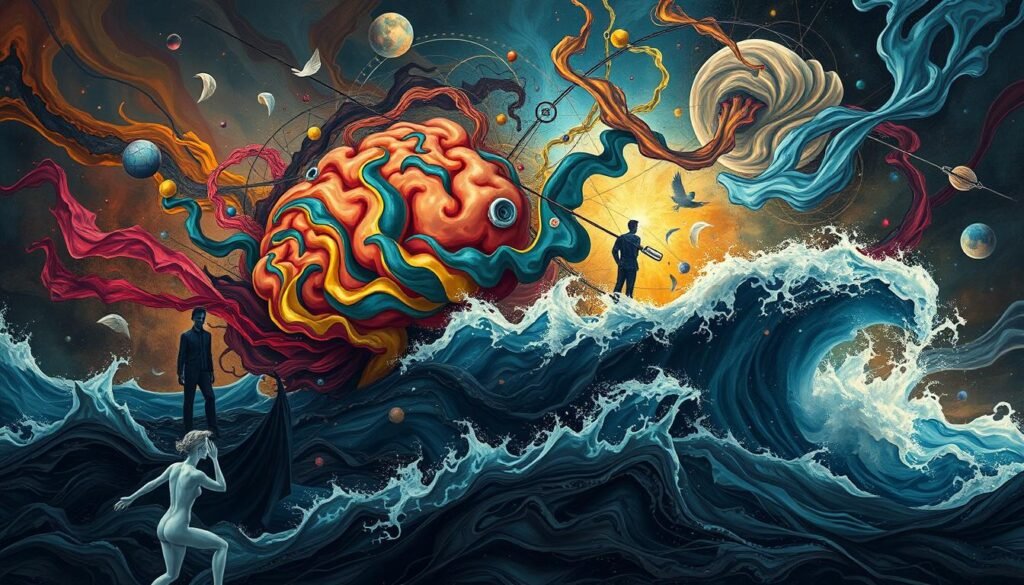Did you know nearly half of adults with ADHD also struggle with anxiety? This fact highlights how ADD and anxiety deeply impact each other. Often, they occur together, affecting mental health and daily activities. The recent pandemic has increased stress, making it harder for those affected.
This piece sheds light on the complex bond between ADD and anxiety. We will look into symptoms, how to treat them, and ways to cope. It’s key to understand this relationship to better mental resilience and stability.
Looking for ways to lessen the symptoms? Check out this helpful resource on managing ADD and anxiety. By learning together, we can tackle the challenges of these conditions.
Key Takeaways
- Nearly 50% of adults with ADHD experience anxiety disorders.
- Up to 80% of adults with ADHD may have at least one psychiatric disorder.
- Anxiety can stem from worries about productivity in individuals with ADHD.
- Effective treatments often involve both medication and therapy.
- Environmental factors and genetics affect the connection between ADD and anxiety.
- Mindfulness and creating routines are key coping strategies.
- The pandemic has greatly increased anxiety, complicating the lives of those with ADHD.
The Connection Between ADD and Anxiety
Understanding how ADD and anxiety are linked shows their complex relationship. ADD symptoms like not paying attention, making impulsive choices, and having trouble with emotions lead to many challenges. People with ADD often find themselves feeling anxious due to these issues. It’s crucial to treat both ADD and anxiety together for effective results.
Understanding ADD and its Symptoms
ADD affects everyday life through various symptoms. The main symptoms of ADD are:
- Difficulty focusing on tasks
- Impulsive decision-making
- Challenges in organizing and completing assignments
- Frequent forgetfulness in daily activities
- Restlessness and fidgeting
These symptoms make school and work tough, leading to frustration and anxiety. The uncertainty of ADD symptoms often triggers anxiety in daily life.
How Anxiety Develops Alongside ADD
Dealing with ADD can lead to anxiety. Studies show half the people with ADD also have anxiety issues. Anxiety comes from:
- Worrying about not doing well in school or work
- Social problems because of impulsive actions and not paying attention
- Having more trouble controlling emotions, which hurts relationships
This cycle makes ADD and anxiety worsen each other. It makes dealing with both harder and affects mental health.
| Condition | Coexisting Disorders (%) | Common Symptoms |
|---|---|---|
| ADD | 50% have anxiety disorders | Inattention, impulsivity, emotional dysregulation |
| Anxiety Disorder | 25% in adults with ADD | Excessive worry, restlessness, difficulty concentrating |
| Children with ADD | 30% experience anxiety | Withdrawal, irritability, sleep disturbances |
This table clearly shows the strong link between ADD and anxiety, with shared symptoms and conditions.
Why Anxiety is Common Among Individuals with ADD
ADD and anxiety are closely linked, creating challenges for many. Studies show that people with ADD are more likely to have anxiety. This is because they often face tough challenges every day.
These challenges can make anxiety worse. It’s like the two conditions feed off each other, making life harder.
Statistics and Research Findings
About half of adults with ADD also have an anxiety disorder. This shows how common it is for these conditions to overlap. If someone has ADD, they might find it hard to focus, plan, or handle daily tasks.
These difficulties can lead to constant frustration. This frustration can turn into chronic anxiety, impacting their happiness and health.
The Role of Stress in Intensifying Symptoms
Stress makes ADD symptoms worse, which can increase anxiety. Problems with time management and meeting expectations can make someone feel not good enough. This feeling often leads to more stress and anxiety.
For those with ADD, anxiety can feel even more overwhelming. Learning how to manage stress is key. It can help reduce both ADD and anxiety symptoms, making mental health better.
Is Anxiety a Symptom of ADD?
Anxiety and ADD have a complicated relationship. Anxiety isn’t officially listed as a symptom of ADD. Yet, there’s a strong connection between them. Many people with ADD experience deep anxiety because of their ADD symptoms. It’s important to think about how anxiety shows up when looking at ADD.
Analysis of Anxiety’s Link to ADD Symptoms
Anxiety and ADD symptoms can look similar, making it hard to tell them apart. Key examples are:
- Persistent worry about daily activities.
- Hard time focusing, especially when stressed.
- Being more forgetful, sometimes mistaken for ADD.
About half of those with ADD might also have an anxiety disorder. This points to the possibility of having both conditions at once. Figuring out if a person has both requires special methods to ensure they get the right help.
Discerning Between ADD and Anxiety Symptoms
Telling the difference between ADD and anxiety symptoms means noticing their unique traits. ADD tends to show up even when things are calm, leading to distractibility and quick actions. On the other hand, anxiety gets worse in stressful situations and makes focusing hard. Knowing which condition is the main concern helps choose the best treatment. Using questionnaires and interviews is key to correctly identify ADD while also addressing anxiety.
| Condition | Common Symptoms | Typical Onset Age | Co-occurrence Rate |
|---|---|---|---|
| ADD | Inattention, impulsivity, forgetfulness | Average 6 years | 50% also have anxiety |
| Anxiety Disorder | Persistent worry, increased fatigue, restlessness | Average 21 years | Common in adults with ADD |
In conclusion, knowing how ADD and anxiety symptoms interact is key. This understanding helps give the right support and treatment to those in need.
Does ADD Make Anxiety Worse?
ADD and anxiety together create a tough situation that can really affect someone’s feelings and daily life. Studies show that nearly half of the people with ADD also fight against anxiety disorders. This mix can make things harder, increasing restlessness and making it tough to focus. Anxiety can come from ADD stress like struggling to get things done, which makes mental health issues worse.
Exploring the Interplay of ADD Symptoms and Anxiety
When someone has ADD and anxiety, it’s like their symptoms get louder. Things like putting things off or not managing time well can make anxiety spike. This makes daily life harder. The way ADD and anxiety overlap means stress goes up, making both sets of symptoms worse. Paying attention to how often someone feels anxious or how well they sleep can show how bad the anxiety from ADD is. It shows why looking at the whole picture is key in treatment.
Impact of ADD on Daily Life and Mental Health
Living with ADD and anxiety affects friendships, work, and how good life feels. Without good ways to handle these, people may feel more emotional pain and have their daily routines turned upside down. Treating both at the same time can lead to better results. This is because the symptoms often mix together, calling for a plan that covers everything. Even though stimulant meds are a go-to for ADD, they can make anxiety worse for some. This means it’s important to watch closely and have a treatment plan that helps with both issues.

ADHD vs. Anxiety: Key Differences
It’s vital to know how ADHD and anxiety disorders differ for the right diagnosis and treatment. They show unique symptoms, but some features might overlap, making it tricky to diagnose. By closely watching and analyzing behaviors, experts can tell them apart more clearly.
Behavioral Differences in ADD and Anxiety
ADHD, a neurodevelopmental disorder, is marked by impulsiveness, hyperactivity, and attention difficulties. Its symptoms vary by situation. For instance, kids with ADHD might find it hard to focus when things are calm. In contrast, those with anxiety may have concentration issues when stressed. These distinctions are important for managing behavior effectively.
Overlapping Symptoms and Diagnostic Challenges
Confusing ADHD with anxiety disorders, like GAD, is common because they share symptoms such as restlessness and trouble concentrating. This can lead to misunderstandings about a person’s needs. A Harvard Medical School study found that an overly active amygdala, seen in anxiety, might link to ADHD traits. This highlights the need for thorough evaluations to properly identify these disorders.
| Condition | Main Symptoms | Age Onset |
|---|---|---|
| ADHD | Impulsivity, hyperactivity, inattention | Typically diagnosed in childhood |
| Anxiety Disorders | Excessive worry, fear, restlessness | Symptoms often begin at ages 6 to 12 |
| Co-occurrence | Increased inattention and anxiety symptoms | Affects both children and adults |
Research shows that about 31% of people with ADHD also qualify for a GAD diagnosis. This highlights how common anxiety disorders are in those with ADHD. Understanding how these conditions overlap can help carve out better treatment plans. To deepen your understanding, check out this resource. It stresses the need to grasp each disorder’s subtleties.
Coping Strategies for Managing ADD and Anxiety
Dealing with ADD and anxiety requires a smart plan that includes different coping methods. These strategies help people overcome everyday hurdles and build emotional strength. By mastering stress management, individuals can greatly better their lives.
Effective Stress Management Techniques
Organized planning is key for those with ADD and anxiety. Using daily planners and reminders keeps things in order and fights chaos. Adding physical activity to your day can lessen impulsivity and restlessness.
Mindfulness is another great tool. It helps grow inner strength by increasing self-awareness and calmness.
Importance of Self-Care in Treatment
Self-care is crucial in easing ADD and anxiety symptoms. Good practices like eating well, staying hydrated, and getting enough sleep have a big impact on mental health. A regular sleep pattern and a comfy room temperature improve sleep. Simplifying your finances can reduce stress about money. Taking part in activities that sharpen focus and cut down on distractions makes managing oneself easier.
ADHD and Anxiety Treatment Options
Treating ADHD and anxiety together requires a detailed plan. This plan often uses medicines and therapy. About 50% of people with ADHD also have generalized anxiety disorder (GAD). This overlap makes choosing the right ADHD treatments important, as each person’s condition is unique.
Medications for Both Conditions
Doctors often prescribe stimulants like Adderall and Ritalin for ADHD. These medicines can last from four to twelve hours. They help with hyperactivity and impulsivity but can have side effects like appetite loss and anxiety. For those worried about addiction, non-stimulant drugs like Atomoxetine (Strattera) and Guanfacine (Intuniv XR) are options. Strattera, interestingly, can also reduce anxiety symptoms.
For treating anxiety, SSRIs and SNRIs are usually the first choice. These include drugs like Zoloft or Lexapro, and Effexor or Cymbalta, which boost serotonin in the brain. Finding the right mix between anxiety and ADHD medications can greatly improve quality of life. Sometimes, treating one condition helps reduce the symptoms of the other.
Psychosocial Therapies: Cognitive-Behavioral Therapy and More
Cognitive-behavioral therapy (CBT) is a top non-drug choice. It helps people change negative thoughts that influence their actions and feelings. Different therapy techniques teach skills to handle ADHD and anxiety challenges. Practices like mindfulness and relaxation exercises are often part of the therapy.
Using both medication and therapy, especially CBT, is very effective for individuals with both conditions. Knowing which condition affects someone more helps create a targeted treatment plan. For more details on medication options and their effects, check out this comprehensive guide here.
| Medication Type | Examples | Common Side Effects | Duration |
|---|---|---|---|
| Stimulant | Adderall, Ritalin | Decreased appetite, anxiety, headaches | 4-12 hours |
| Non-stimulant | Strattera, Intuniv | Upset stomach, mood swings, fatigue | Varies |
| SSRI | Zoloft, Lexapro | Nausea, fatigue, weight gain | Daily |
| SNRI | Effexor, Cymbalta | Dizziness, dry mouth, increased sweating | Daily |
Role of Mindfulness and Relaxation Techniques
Mindfulness and relaxation techniques are crucial for those with ADD and anxiety. They help people become more aware of their thoughts and feelings. This awareness makes it easier to deal with stress. By using mindfulness every day, people can better control their emotions and reduce anxiety.
Benefits of Mindfulness for ADD and Anxiety
Mindfulness helps people focus and be less impulsive, which is great for ADD. Meditation, deep breathing, and paying attention to the moment can help those with anxiety from ADD. Studies show mindfulness makes people more relaxed and clears their minds.
- Promotes better control of emotions, improving understanding and management of reactions.
- Helps with stress relief through relaxation methods that fit personal needs.
- Aids in recognizing what causes anxiety and how to deal with it.
Adding mindfulness to daily life helps people handle their emotions better. It improves self-awareness, bringing peace and better focus, even when distracted. Through mindfulness training, both kids and grown-ups with ADHD see reduced anxiety. These skills make life more rewarding, boosting overall mental health.

Emotional Well-being and the Importance of Support
It’s key to gain emotional support through strong community ties and mental health relationships for those with ADD and anxiety. These connections bring comfort and lessen stress, helping emotional well-being. Having a support network helps understanding and provides coping strategies during tough times.
Finding Supportive Communities
Supportive communities are key for emotional well-being. Joining groups, whether in-person or online, gives people a chance to share stories and advice. Feeling part of a group aids in connection and support, making a positive space for encouragement and resilience.
Efforts to include more social interactions can fight feelings of loneliness, especially in hard times.
Building Positive Relationships for Mental Health
Strong mental health relationships with family, friends, and support groups are very important. Talking openly about challenges and achievements creates a supportive environment. People feel seen and valued.
Studies show helping others can reduce stress and boost your own emotional health. Making these positive connections lays the groundwork for coping and making healthy choices. For more on how emotional support impacts mental health, check out this resource.
ADHD and Anxiety: Impact During the Pandemic
The COVID-19 pandemic has reshaped life in many ways, bringing new challenges. People faced health worries, changes in daily activities, and being alone a lot. Those with ADHD and anxiety felt these changes even more. These pandemic effects increased their struggles, showing the need to look into these effects on mental health.
Increased Stressors and Their Effects
Uncertainty in schooling, jobs, and personal lives added more stress. For those with ADHD, these changes made handling their symptoms harder. About half of the kids with ADHD still have it when they get older. This affects their mental health during the pandemic. In Tehran, as many as 8.6% of people have ADHD, highlighting its widespread impact.
During this time, big worries included:
- Changes to daily life
- Troubles with studying from home
- Feeling more alone
- Worrying more about health and safety
These difficulties made it tough to stay focused and handle ADHD symptoms well.
Adapting Coping Mechanisms in Challenging Times
With more challenges, people had to change how they deal with stress. Keeping a regular schedule became very important. Joining online support groups helped many share and stay strong. Choosing activities that boost mental health during COVID-19, like staying calm and exercising, has been helpful.
We should note these helpful steps for adapting:
- Keeping a steady daily schedule
- Using tech for social contact and support
- Doing physical activities to lessen anxiety
- Trying mindfulness to keep focused

As we keep adjusting, using good coping strategies helps those with ADHD and anxiety stay strong during pandemic effects.
Conclusion
It’s important to understand how ADD and anxiety are connected. This helps us improve how we treat and manage them. These conditions often happen together. So, it’s key to have care that meets each person’s needs. Knowing what’s wrong and how to treat it lets people better deal with their mental health.
A good care plan might include different therapies. Things like behavioral therapy, cognitive-behavioral techniques, and practices to be mindful. These can make someone’s emotional health better. They also help people be stronger when facing hard times. By looking at both ADD and anxiety, people can build a healthier, more balanced life.
The link between ADD and anxiety shows why full care is important. Getting help from a professional is key. It helps make sure the diagnosis is right and the care plan works for both ADD and anxiety. With the right help and support, improving mental health is more possible.